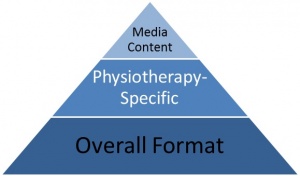What makes a good Physiopedia page
Original Editor - George Pruden Top Contributors - Richard Benes, Kim Jackson, Admin, Tony Lowe and Mahbubur Rahman
Introduction[edit | edit source]
There are three things to consider for every Physiopedia page that you work on.
Overall Format[edit | edit source]
Page title[edit | edit source]
Does the title already exist? Run a search for the page you want to create, or scan through the full list of Physiopedia articles.
Is my title clear and capitalised correctly? The standard format for titles is to capitalise only the first letter of the first word, with the remaining words in lowercase. Try not to use ACRONYMS alone as titles, except in parentheses. Example: Anterior Cruciate Ligament (ACL)
Template[edit | edit source]
Did I use the appropriate template for the page I created? View the Physiopedia templates and choose one that fits the correct category (ie. joint, muscle, ligament, outcome measure, special test). Refer to: Adding Templates tutorial
No template for the page you want to make? Use the new page template and create your own subheadings.
Editors[edit | edit source]
Have I added the editors at the top of the page? For this you need to add a special bit of text to the source code. If it wasn't added with the template often the easiest way to do this is to look at a page that already has the editors correctly displayed, go into the source editing mode, copy the appropriate text and add it to the page you are working on. Refer to: Adding Editors tutorial
Categories[edit | edit source]
Have I categorised the page? All pages must be categorised. Refer to: Adding Categories tutorial
References[edit | edit source]
Did I cite references using the 'cite' tool in the editing toolbar? Be sure to read about Referencing.
Did I use the Vancouver style of referencing? Refer to: Adding References tutorial
Physiotherapy specific and clinically relevant[edit | edit source]
Physiopedia is a universally accessible, online resource specifically created for physiotherapists around the world. A good page, then, should convey knowledge of the profession and current best-evidence practice.
Physiotherapy specific[edit | edit source]
Have I included sections/ headings that are relevant to physiotherapy? Good examples of this include: Pathology/Injury, Physiotherapy Techniques (Palpation, Stretch, Treatment techniques), Clinical Examination (such as Differential Diagnosis, Special Tests and Outcome Measures) and Physiotherapy Management/Intervention. These sections are generally included in the templates.
Have I referenced journals/ articles/ books specific to physiotherapy? The most physiotherapy specific information will come form physiotherapy specific texts, be sure to consult these.
Clinically relevant[edit | edit source]
Have I made the content clinically relevant? Every page should provide information that can potentially impact a persons clinical practice. For example: have you described evidence based physiotherapy interventions for a condition; have you stated why it is important to know about a specific part of the anatomy i.e. how a ligament gets injured; have you demonstrated how to do a special test and stated when it is effective to use that test.
Use of relevant media[edit | edit source]
Physiopedia is designed to be an educational and clinical tool, so visual references (including relevant images, videos and presentations) are great ways to enhance an article.
Examples of relevant media include:
 Images: Anatomy/anatomical, pathology/injury, diagrams, illustrations, etc.
Images: Anatomy/anatomical, pathology/injury, diagrams, illustrations, etc. Videos: Handling or rehabilitation protocols, exercises, or manual techniques (palpation, massage, range of motion).
Videos: Handling or rehabilitation protocols, exercises, or manual techniques (palpation, massage, range of motion). Lectures & Presentations: Anatomy/anatomical, clinical practice guidelines, physiotherapy management, diagnosis, imaging, etc.
Lectures & Presentations: Anatomy/anatomical, clinical practice guidelines, physiotherapy management, diagnosis, imaging, etc.
Did I correctly add/ reference images and videos? Refer to: Adding images and Adding video tutorials. Specifically, we must have permission to use the image or video that we are adding to the page, it should fall under one of the following categories:
- Be copyright free – such as Grays Anatomy Illustrations (for images) and YouTube (for videos)
- Have a creative commons license that allows us to use it – such as Wikimedia Commons
- Be an image/ video that you have created
- Be media that you have specifically had permission to use.







